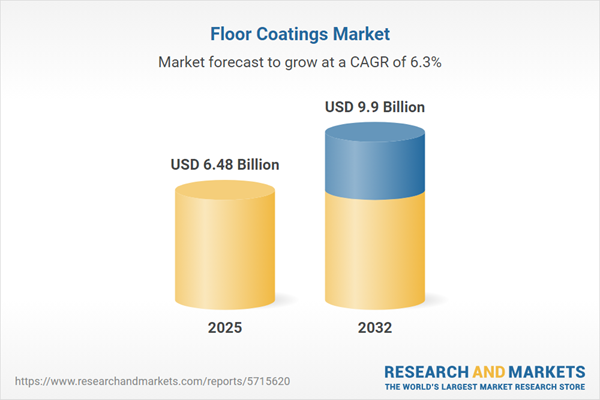Speak directly to the analyst to clarify any post sales queries you may have.
The floor coatings market is evolving with an increased emphasis on durability, sustainability, and cutting-edge application technologies, positioning itself as a key focus for senior leaders seeking to future-proof assets and drive operational efficiency.
Market Snapshot: Advancing Growth in the Global Floor Coatings Market
The floor coatings market grew from USD 6.09 billion in 2024 to USD 6.48 billion in 2025. It is expected to continue growing at a CAGR of 6.25%, reaching USD 9.90 billion by 2032. Rising consumer expectations, coupled with advances in resin technologies and stricter regulatory frameworks, are shaping new standards for productivity and environmental performance. Market participants are responding with tailored product solutions for distinct commercial, industrial, and residential segments, further intensifying competitive differentiation.
Scope & Segmentation: Floor Coatings Market Coverage
- Resin Types: Acrylic, Alkyd, Epoxy, Polyaspartic, Polyurethane
- Formulation Types: Powder, Solvent Based, UV Curable, Water Based
- Application Methods: Brush, Roller, Spray, Trowel
- End Use Sectors:
- Commercial: Education, Healthcare, Hospitality, Retail
- Industrial: Automotive Manufacturing, Chemical Manufacturing, Food & Beverage, Warehouses
- Residential
- Regional Markets: Americas (North America: United States, Canada, Mexico; Latin America: Brazil, Argentina, Chile, Colombia, Peru), Europe, Middle East & Africa (United Kingdom, Germany, France, Russia, Italy, Spain, Netherlands, Sweden, Poland, Switzerland, United Arab Emirates, Saudi Arabia, Qatar, Turkey, Israel, South Africa, Nigeria, Egypt, Kenya), Asia-Pacific (China, India, Japan, Australia, South Korea, Indonesia, Thailand, Malaysia, Singapore, Taiwan)
- Key Industry Players: The Sherwin-Williams Company, PPG Industries, Nippon Paint Holdings, Akzo Nobel, BASF SE, RPM International, Kansai Paint, Axalta Coating Systems, Hempel A/S, Jotun A/S
Key Takeaways: Strategic Insights for Senior Decision-Makers
- Advancements in polymer science and formulation chemistry are introducing new coating systems with improved safety and environmental profiles.
- Water-borne and powder-based technologies are gaining traction as sustainability pressures steer manufacturers toward lower-emission solutions.
- Digital tools supporting predictive maintenance and real-time application monitoring are streamlining project execution and boosting cost control.
- Immediate-cure platforms such as polyaspartic and UV-curable resins are enabling shorter maintenance windows and faster project completion.
- Market leaders are actively investing in R&D and forming regional partnerships to extend reach and accelerate market entry, especially in growth economies.
Tariff Impact and Supply Chain Dynamics
Recent US tariffs on specialty resins and pigments have prompted a strategic shift toward domestic sourcing and greater supply chain agility. Manufacturers and contractors are re-evaluating procurement plans and focusing on regional production to reduce exposure to trade volatility. This adaptation is not only managing short-term risk but is fostering a more resilient market ecosystem for floor coatings.
Methodology & Data Sources
This research integrates primary and secondary methodologies, including expert interviews with formulators, applicators, and facility managers. Technical literature, regulatory documents, and trade data provide further validation, while scenario analysis and competitive benchmarking support robust market insights.
Why This Report Matters
- Enables informed strategic planning and investment in next-generation floor coatings technologies and supply chain resilience.
- Offers critical perspectives for product managers, procurement leads, and executives navigating compliance, performance, and market entry challenges.
- Benchmarking against leading industry players helps organizations identify innovation gaps and partnership opportunities that align with long-term goals.
Conclusion
The floor coatings market is at the intersection of innovation, regulation, and evolving customer needs. This report supports senior leaders in crafting resilient strategies and leveraging technology to remain competitive in a changing landscape.
Additional Product Information:
- Purchase of this report includes 1 year online access with quarterly updates.
- This report can be updated on request. Please contact our Customer Experience team using the Ask a Question widget on our website.
Table of Contents
3. Executive Summary
4. Market Overview
7. Cumulative Impact of Artificial Intelligence 2025
Companies Mentioned
The companies profiled in this Floor Coatings market report include:- The Sherwin-Williams Company
- PPG Industries, Inc.
- Nippon Paint Holdings Co., Ltd.
- Akzo Nobel N.V.
- BASF SE
- RPM International Inc.
- Kansai Paint Co., Ltd.
- Axalta Coating Systems Ltd.
- Hempel A/S
- Jotun A/S
Table Information
| Report Attribute | Details |
|---|---|
| No. of Pages | 187 |
| Published | October 2025 |
| Forecast Period | 2025 - 2032 |
| Estimated Market Value ( USD | $ 6.48 Billion |
| Forecasted Market Value ( USD | $ 9.9 Billion |
| Compound Annual Growth Rate | 6.2% |
| Regions Covered | Global |
| No. of Companies Mentioned | 11 |









